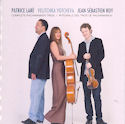 Although resident in Quebec since 1993, Paris-born Patrice Lare studied in Moscow for 8 years, and is steeped in the Russian piano school tradition. His playing provides a massive foundation for the Complete Rachmaninov Piano Trios (XXI-CD 2 1700) with his wife, cellist Velitchka Yotcheva (also Moscow-trained), and Canadian violinist Jean-Sebastien Roy. Rachmaninov’s Trios Elegiaques are both early works in his Romantic, post-Tchaikovsky mold. No.1 is a single-movement trio in G minor from 1892, and No.2 a three-movement work in D minor, written after the death of Tchaikovsky in late 1893 and dedicated “To the Memory of a Great Artist”. This is big but always sensitive playing, perfectly attuned to the style and nature of the music. Recorded at the Radio-Canada studios in Montreal, the sound quality matches the tremendous performances.
Although resident in Quebec since 1993, Paris-born Patrice Lare studied in Moscow for 8 years, and is steeped in the Russian piano school tradition. His playing provides a massive foundation for the Complete Rachmaninov Piano Trios (XXI-CD 2 1700) with his wife, cellist Velitchka Yotcheva (also Moscow-trained), and Canadian violinist Jean-Sebastien Roy. Rachmaninov’s Trios Elegiaques are both early works in his Romantic, post-Tchaikovsky mold. No.1 is a single-movement trio in G minor from 1892, and No.2 a three-movement work in D minor, written after the death of Tchaikovsky in late 1893 and dedicated “To the Memory of a Great Artist”. This is big but always sensitive playing, perfectly attuned to the style and nature of the music. Recorded at the Radio-Canada studios in Montreal, the sound quality matches the tremendous performances.
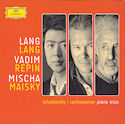 I’ve sometimes wondered if the technical heights reached by Lang Lang are always matched by the depths of his interpretations, but he certainly does his artistic reputation no harm with his first chamber music CD, Tchaikovsky and Rachmaninov Piano Trios with Vadim Repin and Mischa Maisky. Presumably this is his final major release from Deutsche Grammophon (477 8099), following his $3 million signing with Sony; if so, it’s a fascinating farewell, suggesting chamber music as a new field with huge potential for him. The Rachmaninov trio is the G minor, and both here and in the Tchaikovsky A minor trio Lang Lang really seems to avoid “showy” playing, getting to the heart of the music and clearly sharing the interpretative view of his Russian colleagues. Again, the standard of the recording matches that of the two outstanding performances.
I’ve sometimes wondered if the technical heights reached by Lang Lang are always matched by the depths of his interpretations, but he certainly does his artistic reputation no harm with his first chamber music CD, Tchaikovsky and Rachmaninov Piano Trios with Vadim Repin and Mischa Maisky. Presumably this is his final major release from Deutsche Grammophon (477 8099), following his $3 million signing with Sony; if so, it’s a fascinating farewell, suggesting chamber music as a new field with huge potential for him. The Rachmaninov trio is the G minor, and both here and in the Tchaikovsky A minor trio Lang Lang really seems to avoid “showy” playing, getting to the heart of the music and clearly sharing the interpretative view of his Russian colleagues. Again, the standard of the recording matches that of the two outstanding performances.
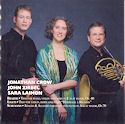 At first sight, there doesn’t seem to be any connection between the works on the latest CD from faculty members at McGill University’s Schulich School of Music (XXI-CD 2 1699), but they are in fact closely related. Jonathan Crow (violin), John Zirbel (horn) and Sara Laimon (piano) open with a beautifully warm reading of the Brahms E flat Horn Trio. This was the first work written for this instrumental combination, and was inspired by the death of the composer’s mother. Brahms chose to use not the newly-developed valve horn but the natural waldhorn, with its sentimental ties to his family and his youth in Hamburg. It was, in turn, a request from a Hamburg pianist for a horn trio to be played along with the Brahms that led György Ligeti to write his own Horn Trio in 1982; moreover, Ligeti had also lost his own mother earlier that year. Sub-titled “Hommage à Brahms”, it is a demanding, complex and multi-layered work in the same four-movement form. Again, the performance is exemplary. Brahms’ mentor Schumann wrote his Adagio & Allegro for horn and piano in 3 days in February 1849; the first substantial solo work to fully explore the potential of the new valve horn, it is still a demanding piece, and Zirbel and Laimon are terrific. Recorded at the acoustically-excellent Schulich School, the sound quality is outstanding.
At first sight, there doesn’t seem to be any connection between the works on the latest CD from faculty members at McGill University’s Schulich School of Music (XXI-CD 2 1699), but they are in fact closely related. Jonathan Crow (violin), John Zirbel (horn) and Sara Laimon (piano) open with a beautifully warm reading of the Brahms E flat Horn Trio. This was the first work written for this instrumental combination, and was inspired by the death of the composer’s mother. Brahms chose to use not the newly-developed valve horn but the natural waldhorn, with its sentimental ties to his family and his youth in Hamburg. It was, in turn, a request from a Hamburg pianist for a horn trio to be played along with the Brahms that led György Ligeti to write his own Horn Trio in 1982; moreover, Ligeti had also lost his own mother earlier that year. Sub-titled “Hommage à Brahms”, it is a demanding, complex and multi-layered work in the same four-movement form. Again, the performance is exemplary. Brahms’ mentor Schumann wrote his Adagio & Allegro for horn and piano in 3 days in February 1849; the first substantial solo work to fully explore the potential of the new valve horn, it is still a demanding piece, and Zirbel and Laimon are terrific. Recorded at the acoustically-excellent Schulich School, the sound quality is outstanding.
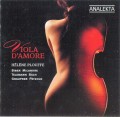 Viola D’Amore
Viola D’Amore

 Although resident in Quebec since 1993, Paris-born Patrice Lare studied in Moscow for 8 years, and is steeped in the Russian piano school tradition. His playing provides a massive foundation for the Complete Rachmaninov Piano Trios (XXI-CD 2 1700) with his wife, cellist Velitchka Yotcheva (also Moscow-trained), and Canadian violinist Jean-Sebastien Roy. Rachmaninov’s Trios Elegiaques are both early works in his Romantic, post-Tchaikovsky mold. No.1 is a single-movement trio in G minor from 1892, and No.2 a three-movement work in D minor, written after the death of Tchaikovsky in late 1893 and dedicated “To the Memory of a Great Artist”. This is big but always sensitive playing, perfectly attuned to the style and nature of the music. Recorded at the Radio-Canada studios in Montreal, the sound quality matches the tremendous performances.
Although resident in Quebec since 1993, Paris-born Patrice Lare studied in Moscow for 8 years, and is steeped in the Russian piano school tradition. His playing provides a massive foundation for the Complete Rachmaninov Piano Trios (XXI-CD 2 1700) with his wife, cellist Velitchka Yotcheva (also Moscow-trained), and Canadian violinist Jean-Sebastien Roy. Rachmaninov’s Trios Elegiaques are both early works in his Romantic, post-Tchaikovsky mold. No.1 is a single-movement trio in G minor from 1892, and No.2 a three-movement work in D minor, written after the death of Tchaikovsky in late 1893 and dedicated “To the Memory of a Great Artist”. This is big but always sensitive playing, perfectly attuned to the style and nature of the music. Recorded at the Radio-Canada studios in Montreal, the sound quality matches the tremendous performances. I’ve sometimes wondered if the technical heights reached by Lang Lang are always matched by the depths of his interpretations, but he certainly does his artistic reputation no harm with his first chamber music CD, Tchaikovsky and Rachmaninov Piano Trios with Vadim Repin and Mischa Maisky. Presumably this is his final major release from Deutsche Grammophon (477 8099), following his $3 million signing with Sony; if so, it’s a fascinating farewell, suggesting chamber music as a new field with huge potential for him. The Rachmaninov trio is the G minor, and both here and in the Tchaikovsky A minor trio Lang Lang really seems to avoid “showy” playing, getting to the heart of the music and clearly sharing the interpretative view of his Russian colleagues. Again, the standard of the recording matches that of the two outstanding performances.
I’ve sometimes wondered if the technical heights reached by Lang Lang are always matched by the depths of his interpretations, but he certainly does his artistic reputation no harm with his first chamber music CD, Tchaikovsky and Rachmaninov Piano Trios with Vadim Repin and Mischa Maisky. Presumably this is his final major release from Deutsche Grammophon (477 8099), following his $3 million signing with Sony; if so, it’s a fascinating farewell, suggesting chamber music as a new field with huge potential for him. The Rachmaninov trio is the G minor, and both here and in the Tchaikovsky A minor trio Lang Lang really seems to avoid “showy” playing, getting to the heart of the music and clearly sharing the interpretative view of his Russian colleagues. Again, the standard of the recording matches that of the two outstanding performances. At first sight, there doesn’t seem to be any connection between the works on the latest CD from faculty members at McGill University’s Schulich School of Music (XXI-CD 2 1699), but they are in fact closely related. Jonathan Crow (violin), John Zirbel (horn) and Sara Laimon (piano) open with a beautifully warm reading of the Brahms E flat Horn Trio. This was the first work written for this instrumental combination, and was inspired by the death of the composer’s mother. Brahms chose to use not the newly-developed valve horn but the natural waldhorn, with its sentimental ties to his family and his youth in Hamburg. It was, in turn, a request from a Hamburg pianist for a horn trio to be played along with the Brahms that led György Ligeti to write his own Horn Trio in 1982; moreover, Ligeti had also lost his own mother earlier that year. Sub-titled “Hommage à Brahms”, it is a demanding, complex and multi-layered work in the same four-movement form. Again, the performance is exemplary. Brahms’ mentor Schumann wrote his Adagio & Allegro for horn and piano in 3 days in February 1849; the first substantial solo work to fully explore the potential of the new valve horn, it is still a demanding piece, and Zirbel and Laimon are terrific. Recorded at the acoustically-excellent Schulich School, the sound quality is outstanding.
At first sight, there doesn’t seem to be any connection between the works on the latest CD from faculty members at McGill University’s Schulich School of Music (XXI-CD 2 1699), but they are in fact closely related. Jonathan Crow (violin), John Zirbel (horn) and Sara Laimon (piano) open with a beautifully warm reading of the Brahms E flat Horn Trio. This was the first work written for this instrumental combination, and was inspired by the death of the composer’s mother. Brahms chose to use not the newly-developed valve horn but the natural waldhorn, with its sentimental ties to his family and his youth in Hamburg. It was, in turn, a request from a Hamburg pianist for a horn trio to be played along with the Brahms that led György Ligeti to write his own Horn Trio in 1982; moreover, Ligeti had also lost his own mother earlier that year. Sub-titled “Hommage à Brahms”, it is a demanding, complex and multi-layered work in the same four-movement form. Again, the performance is exemplary. Brahms’ mentor Schumann wrote his Adagio & Allegro for horn and piano in 3 days in February 1849; the first substantial solo work to fully explore the potential of the new valve horn, it is still a demanding piece, and Zirbel and Laimon are terrific. Recorded at the acoustically-excellent Schulich School, the sound quality is outstanding.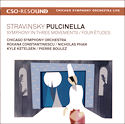 Stravinsky - Pulcinella; Symphony in Three Movements
Stravinsky - Pulcinella; Symphony in Three Movements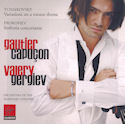 Tchaikovsky - Rococo Variations; Prokofiev - Sinfonia Concertante
Tchaikovsky - Rococo Variations; Prokofiev - Sinfonia Concertante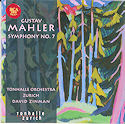 Mahler - Symphony No.7
Mahler - Symphony No.7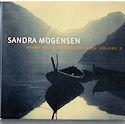 Piano Music of Edward Grieg, Volume 2
Piano Music of Edward Grieg, Volume 2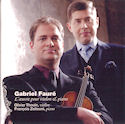 Fauré - Works for Violin and Piano
Fauré - Works for Violin and Piano